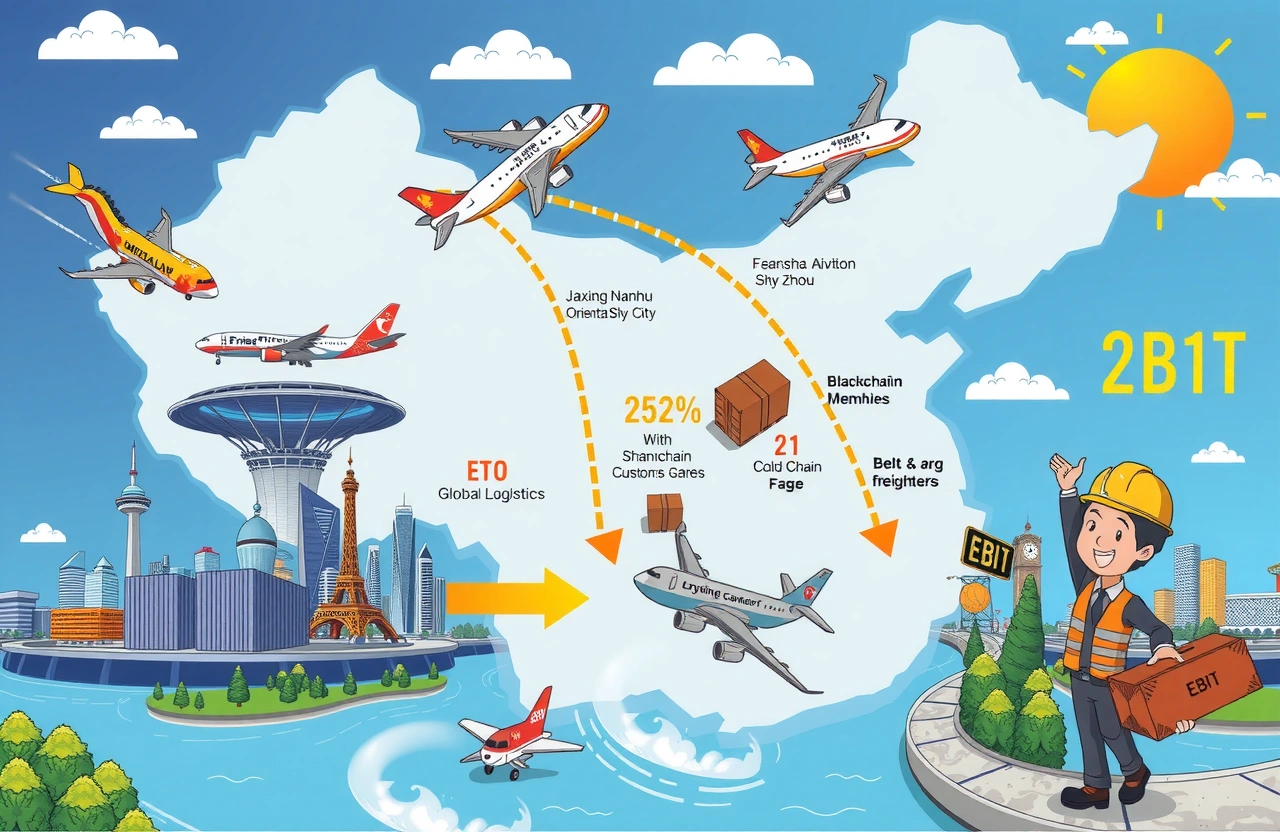The Aviation Cargo Revolution Takes Flight
In a transformative shift reshaping China’s logistics landscape, express delivery giants are racing to establish dedicated aviation hubs across eastern and central China. The explosive 252% year-on-year growth at Ezhou Huahu International Airport – China’s first designated cargo airport – signals how rapidly this niche sector is evolving. As YTO commits to a major hub in Jiaxing and ZTO establishes its air operations base in Changsha, a three-way battle is emerging among Eastern and Central China aviation hubs seeking to dominate the nation’s $175 billion logistics market. These strategic moves fundamentally redefine how goods move across China and globally.
Key developments driving this transformation:
– Ezhou Huahu International Airport processed 22,000 tons of international cargo in H1 2024, ranking fourth nationally just two years after opening
– Jiaxing Nanhu Airport prepares for 2025 launch as Yangtze Delta’s first dedicated freight airport with YTO’s $1.7 billion “Oriental Sky City” project
– ZTO Aviation establishes $83 million Changsha base to develop Hunan’s first cargo airline headquarters
– Nationwide cargo throughput grew 19.2% in 2024, outpacing GDP growth threefold
The Eastern Contender: Jiaxing Nanhu Airport
From Military Base to Logistics Powerhouse
After 13 years of regulatory hurdles, Jiaxing Nanhu Airport is poised to revolutionize the Yangtze River Delta’s cargo infrastructure. The converted military facility overcame major aviation density challenges in a region where Shanghai’s Pudong and Hongqiao airports plus Hangzhou Xiaoshan create some of the world’s most congested airspace. What secured its approval was a specialized cargo-first operational model avoiding passenger plane conflicts.
YTO’s massive investment creates a trifecta of logistics functions: global aviation hub, Yangtze Delta distribution center, and multimodal transport exchange. Scheduled to handle 110,000 tons annually by 2030, it immediately positions among China’s top freight airports. By comparison, Guangzhou Baiyun – currently China’s fourth-busiest cargo airport – moved 2.03 million tons in 2023.
The Regional Synergy Challenge
Logistics expert Yu Jiaxiang (余家祥) notes Jiaxing’s site targets unmet demand: “Zhejiang North and Southern Jiangsu’s biotech, e-commerce and advanced manufacturing clusters generate enormous need for next-flight-out service – precisely where traditional combination airports struggle with belly capacity constraints.” Jiaxing’s business model focuses on dedicated freighter operations using night slots when passenger terminals scale back.
However, competitive concerns persist. Industry analysts predict possible diversion of 8-12% of existing shipments from Shanghai Pudong and Hangzhou Xiaoshan. Yu stresses coordination necessity: “The region needs collaborative systems integrating Jiaxing’s full-freighters with Shanghai and Hangzhou’s belly capacity – balanced competition plus cooperation.” Successful integration could create Asia’s most formidable cargo cluster servicing the world’s largest manufacturing zone.
Central China’s Triple Threat
Changsha’s Aviation Gambit
ZTO’s establishment of its $83 million aviation subsidiary in Changsha marks the latest escalation among Central China aviation hubs. The ambitious project on 123 acres of Changsha Airport Free Trade Zone real estate includes six core components from airline operations to regional headquarters. For ZTO – historically lagging competitors in air capabilities – this creates critical central positioning in China’s logistics geography.
Changsha Huanghua Airport, despite growing cargo volume to 19,980 tons in 2024, ranked a modest 22nd nationally. As ZTO Aviation boots operations with 20 leased freighters, projections suggest 40-50% annual throughput growth. Central China’s 2-hour flight coverage to 90% of Chinese population centers gives this hub enormous scaling potential despite its current underdog status.
The Established Players
Central competition is fierce: Ezhou Huahu Airport exploded onto the scene as China’s fifth-busiest cargo handler in its first full operational year (102,500 tons), while Zhengzhou Xinzheng Airport recorded an all-time high of 80,000 tons. Their divergent growth models highlight the Eastern and Central China aviation hubs arms race.
– Ezhou: Purpose-built around SF Express, leveraging its fleet of 110 freighters and hub-and-spoke system directly modeled on FedEx’s Memphis operation
– Zhengzhou: Organic growth fueled by geographic positioning and free trade zone advantages without a dedicated express partner
The ZTO-Changsha partnership establishes a powerful third contender, with Yu Jiaxiang noting, “Having a homegrown major airline is pivotal for hub competitiveness. Changsha’s potential is immense – pending flawless execution.” This sets the stage for a high-stakes tripartite battle for Midwest cargo supremacy.
The Logistics Giant-Airport Alliance Model
From Factory Floor to Flight Line
The precise coordination between express companies and aviation hubs represents logistics’ most significant evolution since containerization. The pioneering partnership between SF Express and Ezhou Huahu Airport proved the model: dedicated air facilities clustering sorting centers, cold chain infrastructure, and customs clearance within the airport perimeter reduced transfer times from 6+ hours to under 90 minutes for priority shipments.
These synergries deliver compelling advantages:
– All-in-one processing eliminates 40-60% of ground transport handoffs
– Dedicated runway slots accommodate overnight sorting and next-morning deliveries
– Automated parcel handling systems integrate directly with air loading equipment
Jiaxiang Yu observes: “Express-led hubs transform airport-vicinity land into high-value logistics parks. Tenants pay premium rates for cross-dock facilities connecting directly to aircraft loading ramps – real estate appreciates 200-400% faster than conventional airport zones.”
Infrastructure Impacts and Investment
The aviation hub gold rush generates massive infrastructure spending cascading beyond airport boundaries:
– High-speed rail spurs connecting to airports (Changsha extension completed 2023)
– Blockchain-enabled customs facilities (Ezhou model now standard)
– Perimeter highway networks (Jiaxing investing $480 million in ring road upgrades)
All Eastern and Central China aviation hubs have secured national strategic designations. Ezhou holds dual “national logistics hub” and “cold chain base” status while Jiaxing and Changsha recently joined China’s elite logistics hub list. These designations unlock federal funding and policy preferences – including accelerated foreign trade zone approvals and customs policy innovations like deferred duty payments.
The Tri-Regional Showdown
Comparative Advantages
The Eastern and Central China aviation hubs manifest distinct strategic approaches:
East (Jiaxing)
– Primary market: Export-oriented Yangtze Delta manufacturers
– Volume sources: High-value electronics, pharmaceuticals, cross-border e-commerce
– Infrastructure focus: Multimodal transport connecting world’s busiest container ports
Central Region (Ezhou, Zhengzhou, Changsha)
– Primary market: Domestic consumption distribution
– Volume sources: Automotive, agriculture, industrial equipment
– Infrastructure focus: National trunk line integrations with inland markets
This specialization minimizes direct competition while creating complementary networks. The critical divergence emerges in operating models: Jiaxing preserves multi-user flexibility while Ezhou operates essentially as SF Express’s proprietary airport. Airfreight rates data indicates 8-12% pricing differences based on these structural variations.
The Capacity Race
Current expansion projects signal intensifying competition:
– Ezhou launching $580 million phase two adding parallel runway and 350,000㎡ warehouse space
– Zhengzhou constructing third runway specifically for 747-8F freighters
– Changsha planning dedicated cargo terminal quadrupling current capacity
Analysts warn of potential oversupply beyond 2028 if all projects proceed. Current projections show aggregate annual capacity reaching 5.5 million tons by 2030 – triple 2023’s national demand. However, market leader SF Express expects Chinese express volume growing 20% CAGR through 2030 potentially absorbing much new capacity.
Tomorrow’s Aviation Logistics Landscape
Technology as Differentiator
The Eastern and Central China aviation hubs are becoming laboratories for autonomous cargo innovations. Ezhou already deploys 48 driverless tugs transferring unit load devices between terminals. This year brings drone delivery trials from Jiaxing to outer Yangtze islands. Changsha partners with drone manufacturer EHang on self-flying freighter prototypes targeting trials within its bonded zone.
Digital integration provides competitive advantages:
– AI routing algorithms slash fuel consumption 11% at Zhengzhou
– Blockchain documentation reduced average customs clearance from 17 hours to 108 minutes
– Predictive allocation systems optimize special cargo handling 30% faster than manual methods
Innovation extends beyond existing Eastern and Central China aviation hubs. JD Logistics interweaves warehouse robotics with its Nantong air operations while China Postal Airlines deploys automated sortation tech at its Nanjing hub. These advances cumulatively help Chinese airports close efficiency gaps with global leaders Singapore Changi and Memphis.
The Next Dominoes
With most major logistics players now secured to aviation hubs, speculation centers on underserved regions. Industry monitors key signals:
– Northwest China: Xi’an Xianyang Airport strengthening cold chains along Belt & Road routes
– South China: Bao’an expanding cargo facilities near Shenzhen tech corridor
– Policy openings: Civil Aviation Administration hints at greenlighting private airport initiatives
The expanding Eastern and Central China aviation hubs phenomenon represents more than infrastructure – it’s recalibrating regional economies. Inner provinces historically exporting labor now attract logistics-centric jobs paying 2-3 times local averages. Changsha has already secured $1.2 billion in new logistics equipment manufacturing investment since the ZTO announcement.
As millions in daily commerce shift toward specialized aerial networks, businesses must reassess distribution strategies. Review how approaching hub transitions impact your shipping costs and lead times – then engage directly with airport zone developers about preferential access programs for early tenants. The winners in this new logistics paradigm will be those who position operations where the cargo birds flock.




